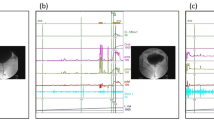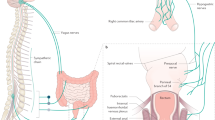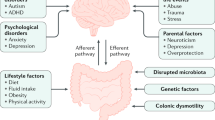Abstract
Biofeedback is a form of treatment that has no adverse effects and can be provided by physician extenders. The therapy relies on patients' ability to learn how to influence their bodily functions through dedicated machinery and teaching. This Review provides a comprehensive overview of all potential therapeutic applications of biofeedback for functional constipation, fecal incontinence, functional anorectal pain, IBS, functional dyspepsia, and aerophagia. Practical clinical applications of biofeedback therapy supported by randomized, controlled trials (RCTs) are limited to fecal incontinence and dyssynergic defecation. For fecal incontinence, RCTs suggest that biofeedback combining strength training and sensory discrimination training is effective in approximately 75% of patients and is more effective than placebo. However, verbal feedback provided by a therapist during extended digital examination may be equally effective, and children whose fecal incontinence is associated with constipation plus fecal impaction do no better with biofeedback than medical management. For dyssynergic defecation, RCTs show that biofeedback combining pelvic floor muscle relaxation training, practice in defecating a water-filled balloon, and instruction in effective straining is effective in approximately 70% of patients who have failed to respond to laxative treatment. For both incontinence and dyssynergic defecation, the benefits of biofeedback last at least 12 months.
Key Points
-
Biofeedback is considered appropriate when specific pathophysiological mechanisms underlying a disordered function are known and the voluntary control of responses can be learned with the aid of systematic information about functions not usually perceived at a conscious level
-
Biofeedback involves motor skills learning, in which patients are provided with augmented feedback on a physiological response to learn to modify it, discrimination training, in which patients are exposed to graded physiological sensations and taught through feedback on accuracy to perceive weaker sensations, or a combination of the two
-
Among patients with functional gastrointestinal disorders, those with functional anorectal disorders have benefited most from biofeedback training; however, practical clinical applications of biofeedback therapy supported by randomized, controlled trials are limited to fecal incontinence and dyssynergic defecation, for which the benefits of biofeedback last at least 12 months
-
Randomized, controlled trials on dyssynergic defecation and fecal incontinence have shown that studies with adequate study samples, standardized treatment protocols and outcomes, and adequate length of follow-up are possible and that they yield more consistent results
-
The future of biofeedback therapy depends on improving research methodology
This is a preview of subscription content, access via your institution
Access options
Subscribe to this journal
Receive 12 print issues and online access
$209.00 per year
only $17.42 per issue
Buy this article
- Purchase on Springer Link
- Instant access to full article PDF
Prices may be subject to local taxes which are calculated during checkout
Similar content being viewed by others
References
Kronke K and Mangelsdorff AD (1989) Common symptoms in ambulatory care: incidence, evaluation, therapy, and outcome. Am J Med 86: 262–266
Drossman DA (2006) The functional gastrointestinal disorders and the Rome III process. Gastroenterology 130: 1377–1390
Mitchell CM and Drossman DA (1987) Survey of the AGA membership relating to patients with functional gastrointestinal disorders. Gastroenterology 92: 1282–1284
Whitehead WE and Schuster MM (1985) Gastrointestinal Disorders: Behavioral and Physiological Basis for Treatment. Orlando: Academic Press
Whitehead WE et al. (2002) Motility as therapeutic modality: biofeedback treatment of gastrointestinal disorders. In Schuster Atlas of Gastrointestinal Motility, edn 2, 381–397 (Eds Schuster MM. et al.) Hamilton, Ontario: BC Decker Inc
Palsson OS et al. (2004) Biofeedback treatment for functional anorectal disorders: a comprehensive efficacy review. Appl Psychophysiol Biofeedback 29: 153–174
Bharucha AE et al. (2006) Functional anorectal disorders. Gastroenterology 130: 1510–1518
Nelson RL (2004) Epidemiology of fecal incontinence. Gastroenterology 126 (Suppl 1): S3–S7
Bharucha AE (2003) Fecal incontinence. Gastroenterology 124: 1672–1685
Engel BT et al. (1974) Operant conditioning of rectosphincteric responses in the treatment of fecal incontinence. N Engl J Med 290: 646–649
Heymen S et al. (2001) Biofeedback treatment of fecal incontinence: a critical review. Dis Colon Rectum 44: 728–736
Chiarioni G et al. (2005) Biofeedback treatment of fecal incontinence: where are we, and where are we going? World J Gastroenterol 11: 4771–4775
Chiarioni G et al. (1993) Liquid stool incontinence with severe urgency: anorectal function and effective biofeedback therapy. Gut 34: 1576–1580
Wald A and Tunuguntla AK (1984) Anorectal sensorimotor dysfunction in fecal incontinence and diabetes mellitus. Modification with biofeedback therapy. N Engl J Med 310: 1282–1287
Buser WD and Miner PB (1986) Delayed rectal sensation with fecal incontinence: successful treatment using anorectal manometry. Gastroenterology 91: 1186–1191
Chiarioni G et al. (2002) Sensory retraining is key to biofeedback therapy for formed stool fecal incontinence. Am J Gastroenterol 97: 109–117
Miner PB et al. (1990) Investigation of mode of action of biofeedback in treatment of fecal incontinence. Dig Dis Sci 35: 1291–1298
Heymen S et al. (2000) A prospective randomized trial comparing four biofeedback techniques for patients with fecal incontinence. Colorectal Dis 2: 88–92
Norton C et al. (2003) Randomized, controlled trial of biofeedback for fecal incontinence. Gastroenterology 125: 1320–1329
Solomon MJ et al. (2003) Randomized, controlled trial of biofeedback with anal manometry, transanal ultrasound, or pelvic floor retraining with digital guidance alone in the treatment of mild to moderate fecal incontinence. Dis Colon Rectum 46: 703–710
Heymen S et al. (2007) Randomized controlled trial shows biofeedback to be superior to alternative treatments for patients with fecal incontinence. Gastroenterology 132 (Suppl 2): A83
Whitehead WE et al. (1986) Treatment of fecal incontinence in children with spina bifida: comparison of biofeedback and behavior modifications. Arch Phys Med Rehabil 67: 218–224
van der Plas RN et al. (1996) Randomised trial of biofeedback training for encopresis. Arch Dis Child 75: 367–374
van Ginkel R et al. (2000) Lack of benefit of laxatives as adjunctive therapy for functional nonretentive fecal soiling in children. J Pediatr 137: 808–813
Whitehead WE et al. (2001) Treatment options for fecal incontinence. Dis Colon Rectum 44: 131–144
Lembo A and Camilleri M (2003) Chronic constipation. N Engl J Med 349: 1360–1368
Surrenti E et al. (1995) Audit of constipation in a tertiary referral gastroenterology practice. Am J Gastroenterol 90: 1471–1475
Chiarioni G et al. (2006) Biofeedback therapy for dyssynergic defecation. World J Gastroenterol 12: 7069–7074
Heymen S et al. (2003) Biofeedback treatment of constipation: a critical review. Dis Colon Rectum 46: 1208–1217
Rao S et al. (1997) Effects of biofeedback therapy on anorectal function in obstructive defecation. Dig Dis Sci 42: 2197–2205
Bleijenberg G and Kuijpers HC (1987) Treatment of the spastic pelvic floor syndrome with biofeedback. Dis Colon Rectum 30: 108–111
Keck JQ et al. (1994) Biofeedback training is useful in fecal incontinence but disappointing in constipation. Dis Colon Rectum 37: 1271–1276
Lau CW et al. (2000) Prognostic significance of rectocele, intussusception, and abnormal perineal descent in biofeedback treatment for constipated patients with paradoxical puborectalis contraction. Dis Colon Rectum 43: 478–482
Loening-Baucke V (1990) Modulation of abnormal defecation dynamics by biofeedback treatment in chronically constipated children with encopresis. J Pediatr 116: 214–222
Loening-Baucke V (1995) Biofeedback treatment for chronic constipation and encopresis in childhood: Long-term follow-up. Pediatrics 96: 105–110
van der Plas RN et al. (1996) Biofeedback training in treatment of childhood constipation: a randomised controlled study. Lancet 348: 776–780
Wald A et al. (1987) Evaluation of biofeedback in childhood encopresis. J Pediatr Gastroenterol Nutr 96: 554–558
Koutsomanis D et al. (1995) Controlled randomized trial of visual biofeedback versus muscle training without a visual display for intractable constipation. Gut 37: 95–99
Chiotakakou-Faliakou E et al. (1998) Biofeedback provides long term benefit for patients with intractable, slow and normal transit constipation. Gut 42: 517–521
Eckardt VF (2006) Is biofeedback therapy an effective treatment for patients with constipation. Nat Clin Pract Gastroenterol Hepatol 3: 198–199
Chiarioni G et al. (2005) Biofeedback benefits only patients with outlet dysfunction, not patients with isolated slow transit constipation. Gastroenterology 129: 86–97
Chiarioni G et al. (2006) Biofeedback is superior to laxatives for normal transit constipation due to pelvic floor dyssynergia. Gastroenterology 130: 657–664
Rao S et al. (2007) Randomized controlled trial of biofeedback, sham feedback, and standard therapy for dyssynergic defecation. Clin Gastroenterol Hepatol 5: 331–338
Heymen S et al. (2007) Randomized, controlled trials shows biofeedback to be superior to alternative treatments for patients with pelvic floor dyssynergia-type constipation. Dis Colon Rectum 50: 1–14
Grimaud JC et al. (1991) Manometric and radiologic investigations and biofeedback treatment of chronic idiopathic anal pain. Dis Colon Rectum 34: 690–695
Heah SM et al. (1997) Biofeedback is effective treatment for levator ani syndrome. Dis Colon Rectum 40: 187–189
Ger GC et al. (1993) Evaluation and treatment of chronic intractable rectal pain—a frustrating endeavour. Dis Colon Rectum 36: 139–145
Gilliland R et al. (1997) Biofeedback for intractable rectal pain: outcome and predictors of success. Dis Colon Rectum 40: 190–196
Longstreth GF et al. (2006) Functional bowel disorders. Gastroenterology 130: 1480–1491
Longstreth GF (2005) Definition and classification of IBS: current consensus and controversies. Gastroenterol Clin North Am 34: 173–187
Furman S (1973) Intestinal biofeedback in functional diarrhea: a preliminary report. J Behav Ther Exp Psychiatry 4: 317–321
Radniz CL and Blanchard EB (1983) Bowel sounds biofeedback as a treatment for irritable bowel syndrome. Biofeedback Self Regul 13: 169–179
Leahy A et al. (1998) Computerised biofeedback games: a new method for teaching stress management and its use in irritable bowel syndrome. J R Coll Physician Lond 32: 552–556
Neff DF and Blanchard EB (1987) A multicomponent treatment for the irritable bowel syndrome. Behav Ther 18: 70–73
Blanchard EB and Schwarz SP (1987) Adaptation of a multicomponent treatment program for irritable bowel syndrome to a small group format. Biofeedback Self-Reg 12: 63–69
Schwarz SP et al. (1986) Behavioral treatment of irritable bowel syndrome: a 1 year follow-up study. Biofeedback Self-Reg 11: 189–198
Blanchard EB et al. (1992) Two controlled evaluations of multicomponent psychological treatment of irritable bowel syndrome. Behav Res Ther 30: 175–189
Tack J et al. (2006) Functional gastroduodenal disorders. Gastroenterology 130: 1466–1479
Tack J et al. (2004) Pathophysiology and treatment of functional dyspepsia. Gastroenterology 127: 1239–1255
Stern RM et al. (2004) Electrogastrographic biofeedback: a technique for enhancing normal gastric activity. Neurogastroenterol Motil 16: 753–757
Whitehead WE and Drescher VM (1980) Perception of gastric contractions and self-control of gastric motility. Psychophysiology 17: 522–558
Hjelland IE et al. (2007) Breathing exercises with vagal biofeedback may benefit patients with functional dyspepsia. Scand J Gastroenterol 42: 1054–1062
Calloway SP et al. (1983) Behavioural techniques in the management of aerophagia in patients with hiatus hernia. J Psychosom Res 27: 499–502
Author information
Authors and Affiliations
Corresponding author
Ethics declarations
Competing interests
The authors declare no competing financial interests.
Rights and permissions
About this article
Cite this article
Chiarioni, G., Whitehead, W. The role of biofeedback in the treatment of gastrointestinal disorders. Nat Rev Gastroenterol Hepatol 5, 371–382 (2008). https://doi.org/10.1038/ncpgasthep1150
Received:
Accepted:
Published:
Issue Date:
DOI: https://doi.org/10.1038/ncpgasthep1150
This article is cited by
-
Fecal incontinence: challenges in electrodiagnosis and rehabilitation
Egyptian Rheumatology and Rehabilitation (2023)
-
Therapeutisches Management der chronischen Obstipation
Schweizer Gastroenterologie (2022)
-
Diagnosis and Management of Functional Heartburn
American Journal of Gastroenterology (2016)
-
Biofeedback treatment of chronic constipation: myths and misconceptions
Techniques in Coloproctology (2016)
-
Biofeedback therapy for constipation due to dyssynergic defecation: ready for prime time
Techniques in Coloproctology (2015)



